Contents
Blackberry without thorns is an excellent achievement of breeders, which allows you to grow this very useful and tasty berry in summer cottages or home gardens. Everyone knows about the merits of this culture, but rare gardeners dared to mess with thorny shoots, because when caring for blackberries, the gardener often has to come into contact with branches. Varieties of thornless blackberries usually have a number of other advantages: a large yield, large berries, disease resistance, and frost resistance.
General information about the culture
The blackberry belongs to the Rubus genus of the Pink family, along with its closest relative, the raspberry, which the thorns have not prevented from taking root in our dachas for a long time. Blackberries are not grown on an industrial scale in our country, only private and small farms have recently become interested in this crop. But delicious sweet and sour berries contain a lot of vitamins, elements, sugars and dietary fiber, which bring undoubted benefits to the human body. There are fresh berries recommended for people with problems of the cardiovascular system, neurosis, atherosclerosis, diseases of the kidneys, gastrointestinal tract, joints, after suffering from pneumonia, bronchitis or other serious diseases. They have a beneficial effect on a weakened body, cleanse it of toxins and toxins, strengthen the immune system.
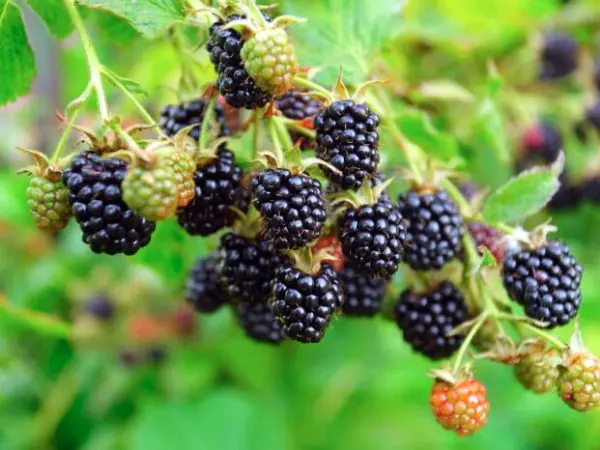
In Europe, blackberries are most widespread in Great Britain and Poland, but there is no talk of industrial cultivation there either. But the United States and Mexico have long been growing it for commercial purposes, and it is from Mexico that the fresh berry comes to European markets.
Blackberry thornless is a picturesque openwork bush, its green leaves with a jagged edge are divided into three parts and slightly pubescent. In mid-June (as a rule) white flowers appear with a pink or lilac tint, and then small green berries. In most varieties, the fruiting period is extended for a month or more, so almost all summer you can observe flowers and berries of different colors – first green, then reddening, rich red, black or purple in the ripening period. Often there is all the color variety at the same time on one bush.
The roots of the shrub grow up to one and a half meters, so it can survive periods of drought, despite the fact that traditional varieties of blackberries need regular and sufficient watering, without which the yield decreases and the berries lose their sweetness.

Blackberry is cultivated as a biennial crop – in the first year of shoot growth, fruit buds are only laid, and in the second, flowers and fruits are formed. After fruiting, the shoots must be completely cut and burned. They are cut off near the ground in the fall, when the blackberries are being prepared for winter, and new ones that have grown this year will take their place. This cycle is reminiscent of raspberries, with which blackberries are often compared. Unlike the prickly relative, the blackberry gives a much larger yield, but tolerates frosts worse. There are very successful hybrids that combine the best taste qualities of these two crops, they are much easier and more pleasant to grow.
An exception to the two-year cycle are remontant varieties of blackberries and raspberries. They bring a harvest annually, and cut them off completely in the fall, new shoots grow in the spring, which bear fruit this year.
All non-thorny blackberries, like their thorny ancestors, are divided into two conditional types – kumaniki and dewberries.
Kumaniki are straight-growing varieties, their shoots grow up to 2 or 3 meters strong and not very flexible, which makes them difficult to shelter for the winter. They usually give a lot of replacement shoots and root offspring. Tassels of fruits are formed directly on the main branch. They are tied to supports. Vivid examples: “Polar”, “Apache”, “Guy”.
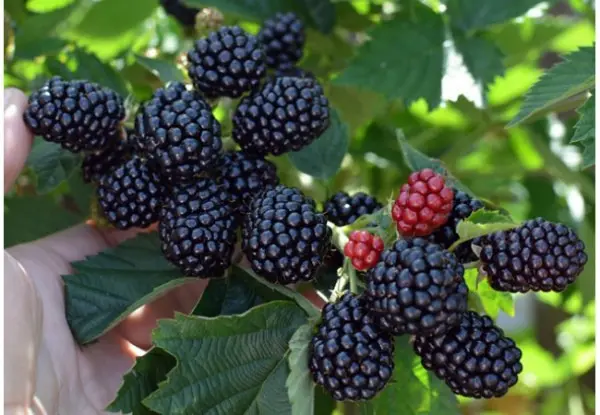
Dewberries grow strong, but flexible, creeping shoots on the ground from 4 to 6 meters. Flowers and fruits are formed on special short fruit twigs that grow away from the main branch along the entire length. They do not give root offspring (only if the root is damaged), but they can turn your site into a wild thicket if they are not attached in an orderly manner to the trellises. Representatives known to us: Thornfree, Black Satin.
But there are also varieties such as Triple Crown, whose shoots up to half a meter (or higher) grow steadily upwards, and then begin to lean to the side and spread along the ground.
Popular varieties
Compared to other European countries, blackberries are not yet very common in our country. But gardeners will be interested to know that there are enough varieties and hybrids that have been tested by our compatriots that grow confidently even in such difficult climatic conditions as short summers or cold winters. These are, as a rule, varieties of British or American selection. Among them there are upright, creeping and semi-shrubs that have not yet decided which type to join them.
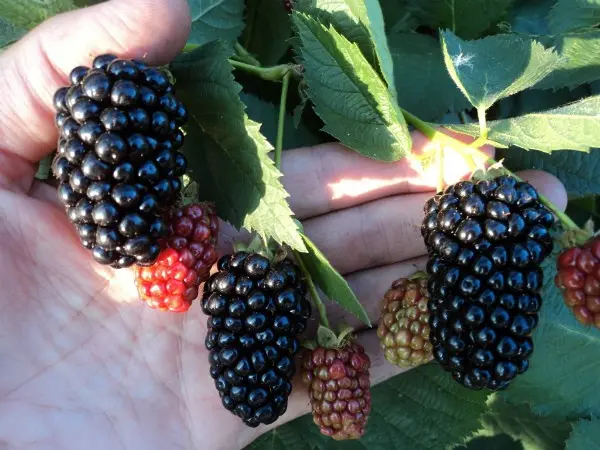
If you want to collect ripened fruits as early as possible, then you should plant Apaches. This is a straight-growing variety of American selection, it begins to bear fruit in the second half of June, for 5 weeks you can feast on large sweet conical berries.
A month later, the fruits of such varieties as Loch Tay, Polar, Natchez begin to ripen. Moreover, the English variety “Loch Tay” gives fruits for only 2 weeks, which is not very typical for blackberries with its extended fruiting period. Its shoots are semi-upright, and the berries are oval black.
The Polish “Polar” begins to give its large round sweet and sour fruits from mid-July, and the latter can be plucked in September. Shoots are upright.
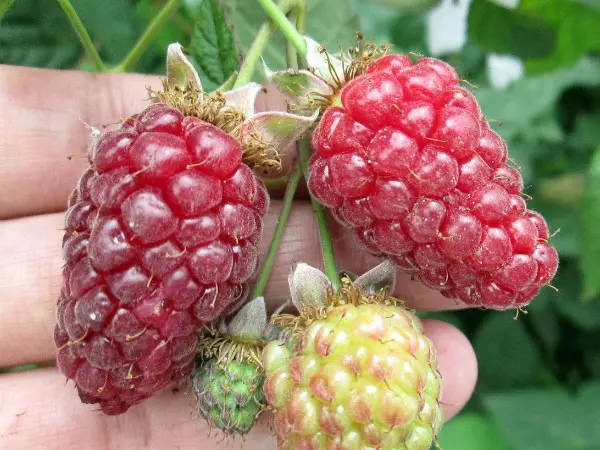
For 5 weeks, starting from mid-July, the berries of the American “Natchez” ripen. It is famous for its very large sweet fruits. Each of these elongated black berries weighs 12 to 16 grams.
From the beginning of July to mid-August, a completely wonderful fairly new hybrid of blackberry and raspberry “Buckingham Tayberry” pleases with its fruits. Its long red berries reach 8 cm in length and 15 g in weight, they are distinguished by a strong aroma, rich taste with pronounced sourness.
For half a century there has been a variety of “Thornfree”, one of the most famous for our summer residents. Its shoots are semi-spreading, grow up to 4,5 m. The bush charms with its bright leaves, large (more than 3 cm in diameter) slightly pinkish flowers, and throughout August this composition is complemented by ripening purple-black ovoid fruits. Berries with an average weight of 5 g should be harvested as soon as they ripen, overripe ones become too soft, lose their sourness in taste and transportability.
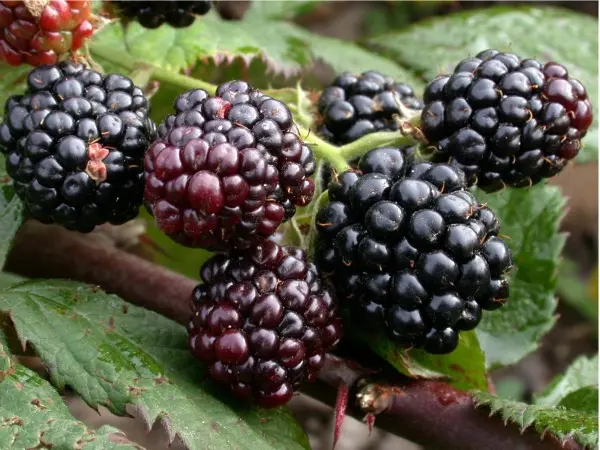
“Navajo” pleases with very fragrant shiny black berries throughout August, its shoots are upright.
“Chester Thornless” is considered winter-hardy, its semi-creeping branches are covered with pink flowers in June, and already in August they give shiny black fruits of a pleasant delicate taste.
In the second half of August, the glossy black berries of Black Satin begin to ripen, its shoots first grow steadily upwards, and after breaking the 60 cm mark, they turn and grow horizontally.
Blackberry “Loch Ness” Scottish selection begins to ripen by the end of August. Berries of 5 g in weight perfectly retain their qualities for several days after harvesting, they endure transportation without loss, and are convenient for commercial cultivation.
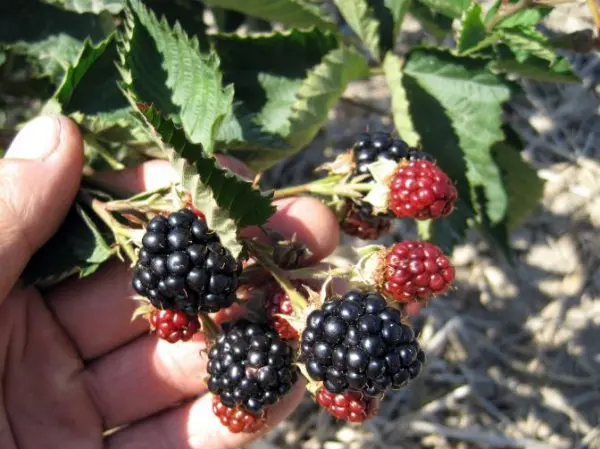
Up to 15 kg of sweet fragrant black berries with an average weight of 7-8 g can be collected from one Triple Crown bush. They ripen during August and September, they surprise with a cherry flavor.
Of the remontant varieties, Ruben is the most famous. True, it cannot be called thornless – the thorns grow along with the shoots, but fall off with the ripening of the berries, after harvesting it becomes exactly thornless. Its big plus lies in the ability to bear fruit twice a season and winter well after pruning all the shoots.
Video “Blackberry Loch Tay”
This review will give an idea of one of the earliest varieties of cultivated thornless blackberry with a tasty and sweet berry – Loch Tay.
Advantages and disadvantages
Compared to raspberries, all of the listed and many unmentioned varieties make it possible to harvest a much larger crop. The protracted ripening of fruits in time is very convenient for private households, when people want to improve their health, strengthen immunity with the help of delicious berries. You can enjoy fresh berries for up to 2 months, picking them every 2-3 days. For commercial cultivation, this may be a disadvantage, but the Mexican companies that supply blackberries to Europe clearly do not suffer from this.
Deep-growing roots will provide the bush with moisture, even if the owner could not arrive at the dacha in time for watering, which clearly facilitates the growing chores. Late flowering of blackberries does not allow it to suffer from possible spring frosts, and late fruit ripening occurs after the main harmful insects that are hungry for sweet berries have flown out. The absence of thorns makes it possible to take care of this crop with pleasure, and facilitates literally all agrotechnical activities.
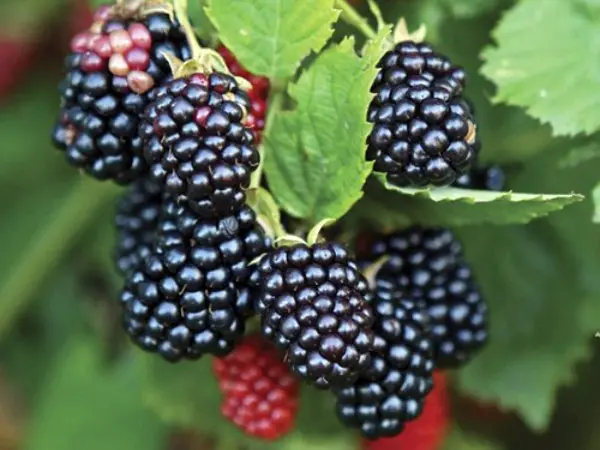
Most thornless varieties and hybrids are resistant to common diseases, which is good news.
The traditional disadvantage of all good plants is the high price of seedlings. But blackberries are easy to propagate, and root offspring, layering and cuttings perfectly retain the properties of mother plants. This can become an income item along with the sale of berries.
Peculiarities of growing
For the quality of blackberries, it is very important that the bush receives sufficient nutrition from the soil and the right amount of sunlight. Therefore, you need to choose a good open place, organize a fairly light nutrient soil. Loam with lots of humus is best, the soil should be more alkaline than acidic. It is better to prepare the site for planting in the fall – dig up the ground, clean it of weed roots, add humus or compost, ash or dolomite flour. But it is better to plant in the spring, this guarantees the rooting and growth of a young plant.
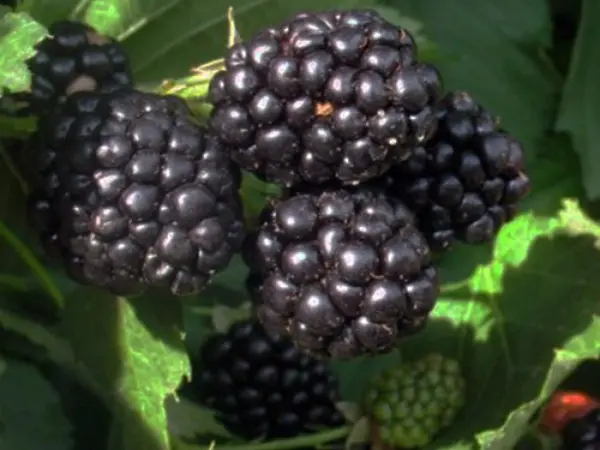
A hole needs to be dug for a bush that will grow and bear fruit in this place for up to 15 years, and its roots will grow to a depth of more than half a meter – that is, like for a tree. The depth and width of the pit should be at least 60 cm, the ground with fertilizers is laid to the bottom, then it is simply sprinkled with earth so that the young roots do not come into contact with fertilizers in order to avoid burns. Further, mineral fertilizers and humus are applied every few years in the spring. If necessary, the plant is fed when it blooms, sets fruits, it is better to use a complex of mineral fertilizers at this time with an emphasis on potassium, nitrogen is applied only in spring.
Blackberries must be pruned twice a year. In the fall, all fruit-bearing shoots are cut out, and among the young, the weakest and most damaged ones are removed. The remaining shoots are shortened by a quarter, folded, placed in a prepared hole or simply under cover. In winter they are covered with snow. In the spring, the shelter is removed, the whips are unfolded, and sanitary pruning is carried out, if necessary. Leave 5-9 (depending on the variety) new shoots that will bear fruit this year. Then they install supports and tie up the shoots. Kumaniki are strengthened on a support with a fan or a bowl, where fruit-bearing shoots are directed in one direction, and young ones that will only grow in the other. Dewberries are braided on a wire stretched parallel to the ground at a distance of 50 cm, 100 cm and 150 (170) cm from it. For convenience, fruiting shoots and growing shoots are also directed in different directions. In autumn they are unwound and cut.
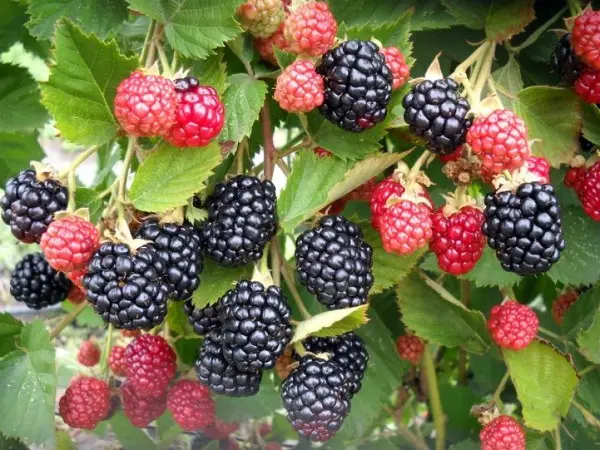
Thinness of care
Some gardeners shorten fruit-bearing shoots in summer or spring so that straight-growing ones give side shoots, and creeping ones give more fruit twigs. This is not a mandatory event, but rather a trick that helps increase productivity. But you need to do this only with adult bushes, so that they have the strength to grow all these branches and fruits.
If shoots with thorns appear, they must be cut ruthlessly so as not to lose such a convenient dignity.
The berries of some varieties can melt from too hot sun, then a net is pulled over the bush for shading.
It is believed that the ground around the bushes must be loosened. Yes, the roots need air access, but it is better to mulch with peat, compost or humus, this will keep looseness and moisture, prevent weeds from growing and protect the roots from possible injury during loosening and weeding.
It is necessary to water at the very beginning of growth, during flowering and in the fall before harvesting for the winter. The rest of the time, thornless blackberries can easily endure periods of drought.
Video “Growing one of the varieties of thornless blackberry Natchez”
This video will tell you about the features of growing and caring for thornless Natchez blackberries.









